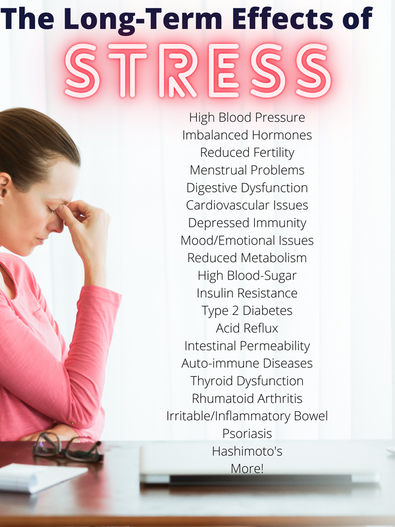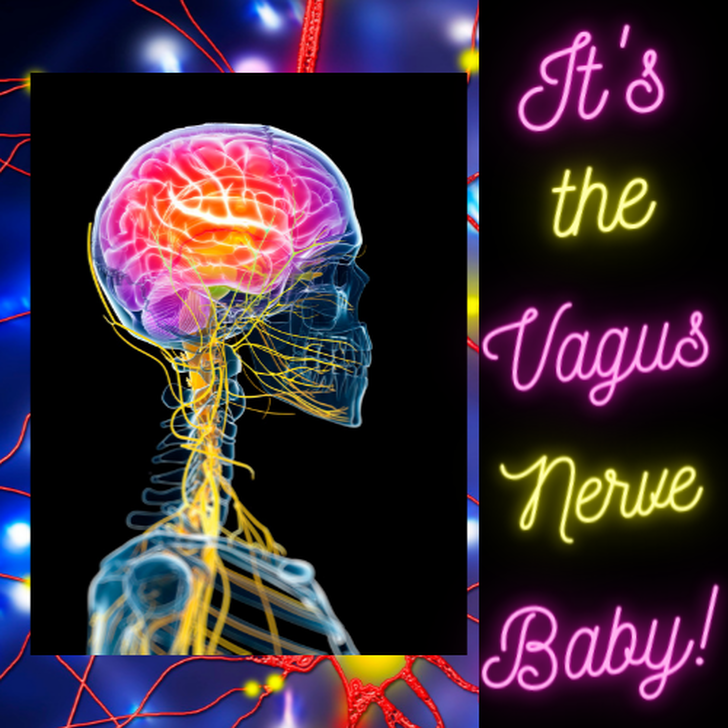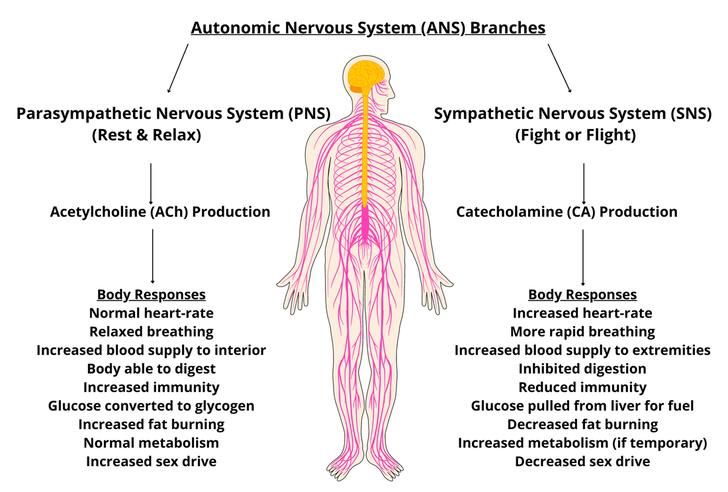|
As overstimulating (and “hangover-inducing”) as the “Vagus Nerve” might sound, it is extremely important for the function of some vital organ functions and is a key component in activating the Parasympathetic Nervous System (PNS; the state of rest and relaxation and/or digestion of the body). Stimulating this nerve helps to interrupt the body's stress responses, which can be the cause of numerous health issues that I will outline below. But first, the Nerve(s) The vagus nerve is one of 12 cranial nerves that runs from the brain stem directly to the organs that it affects (bypassing the spine) that are referred to as the effector organs. In the case of the vagus nerve, these effector organs are the heart, lungs, liver, gallbladder, stomach, and intestines (Archer et al., 2013). When the brain receives stimulus suggesting that the body is under stress (whether these be hormonal feedback loops or outward as well as inward influences), this information is relayed from the brain to the effector organs via the vagus nerve. The result is increased heart rate and respiration, and decreased function of the digestive organs which is a response of the Sympathetic Nervous System (SNS; the state of fight/flight). This response redirects energy that would normally go toward digestion and assimilation to responses of perceived threats. You might be familiar with the sensations of having “butterflies” in your stomach or a racing heart when you are nervous. You can thank the direct link between your brain and your heart and digestive organs via the vagus nerve (and the response of the SNS) for this. However, through the employment of some techniques that are outlined below, the vagus nerve can be stimulated to send communication back to the brain which then in turn tells the Central Nervous System (CNS) to calm down. (Please see a previous blog post in the “Geek Section” for more information on the CNS). Signals from the CNS can then disrupt hormonal feedback loops which can perpetuate the stress response. Warning: This post runs a little long, so if you'd just like to scroll ahead to the end to see the ways of stimulating the Vagus Nerve, I totally get it! Otherwise the sciencey stuff.... A Quick Lesson about the Parasympathetic Nervous System (PNS) & the {say it with me} Hypothalamic-Pituitary-Adrenal (HPA) Axis Before getting too far into the vagus nerve, I do need to discuss the Parasympathetic Nervous System (PNS). It is one of two branches of the Autonomic Nervous System (ANS), along with the Sympathetic Nervous System (SNS) (Cabral, 2017) which is our “Fight or Flight” response. The ANS oversees subconscious activities such as our heartbeat and breathing (Newman, 2022) and is a crucial factor in moving food through the digestive tract as well as how our nervous system responds to stimuli that we experience. The HPA axis refers to a chain reaction of hormones that originate at the hypothalamus and travels to the pituitary and then adrenal glands. Stimuli from the brain sends a signal to our hypothalamus which, through this hormonal pathway, prompts the release of either acetylcholine (ACh) or catecholamines (precursors to cortisol: norepinephrine or epinephrine; CA’s) which directs what the body puts its energy toward, either survival mode or rejuvenation mode. When our bodies are in a PNS (rest and relax state), ACh is released which then leads to further hormone responses for normal body functions such as healthy digestion and reproduction. This is the state that our bodies are intended to be in most of the time. When our bodies are in a SNS (fight or flight state), CA’s are released which leads to a {hopefully} temporary stress response and then to a reduction in vital organ functions so that energy can be supplied to the extremities (arms for fighting, legs for running, as well as increased breathing, heart rate, and glucose production to power it all). Both systems have their place and are necessary factors in maintaining the human body. Responses of the PNS & SNS (Archer et al., 2013; Cabral, 2017) Long-term effects of Stress However, today, we tend to get stuck in a prolonged stress response due to daily stressors such as finances, time-crunches, and environmental stressors which wreak havoc on our health in several ways. These include hormonal, reproductive, digestive, cardiovascular, immunity, emotional, and mental health issues. Additionally, our metabolism is thrown out of whack because of sustained high blood glucose levels which leads to several body dysfunctions such as insulin resistance as well as type 2 diabetes (Diabetes UK, n.d.). Fat burning also stops since the bodies preferred fuel source is glucose and when we are under stress, glucose is in high supply. A couple of crucial factors to highlight here are the effects of stress on the digestive and immune systems since so many of us struggle in these two areas (which affects other body functions as well). When our bodies are consistently in a state of high stress, our digestion suffers in many ways. These include weakened production of stomach acids and digestive enzymes, as well as reduced bowel peristalsis (motility). This can lead to digestive problems, intestinal permeability, inflammation, and immune-based issues such as autoimmune disease(s), thyroid dysfunction, and long-term “dis-eases” (states of being in dis-ease) like rheumatoid arthritis, inflammatory and/or irritable bowel disease, psoriasis, Hashimoto's, and more. As you can see, I could go on and on and it would take many more posts to discuss all the effects of stress on the body. In short though, our entire body system suffers and is thrown out of whack. If you are interested in reading more about the effects of stress and how to mitigate it, please hop over to my previous posts: Reflexology & Stress Eat Your Stress Goodbye And now, without further ado...... Vagus to the Rescue! Stimulating the vagus nerve is beneficial for physical and mental health, as its effects are decreased overall heart rate, lowered blood pressure, and improved digestion as well as improved stress recovery. This is due to what is referred to as “vagal tone” which is a health indicator measured by variability of the heart rate between inhaling and exhaling. When there is higher variability between these two numbers, this is considered good vagal tone and is an indicator of general good health (Heller, n.d.). Stimulating the vagus nerve helps to increase vagal tone and improves how the body is currently responding to stress as well as how it will respond to stressors in the future. Methods of Stimulating the Vagus Nerve: Pranayama (Breathing Exercises): The Belly Breath is one of the quickest ways of calming the nervous system via the vagus nerve. It is done by drawing long, slow, and deep breaths through the nose and into the belly, holding momentarily, and then softly blowing the breath out through the mouth. This can be done as few as 3 times or until your desired state of calm is achieved. What is so great about this is that we can consciously access the effector organs (namely the lungs and digestive organs) which communicate directly with the vagus nerve by using this breath. Other forms of Pranayama such as Nadi Shodhana (alternate nostril breathing), Visamarvrtti (square or same breath), the Complete Yogic Breath (drawing the air into the belly, then filling up the lungs and releasing in reverse order) are also great ways and can be searched on the internet. Chanting or Humming: Another way to stimulate the vagus nerve is to do a breathing meditation using the ‘aum’ technique in which you take relaxed long and deep breaths and then as you exhale you recite the vowels AAAAAAAA-UUUUUUUU-MMMMMMMM (pronounced AH-OO-MM, in one pro-longed exhalation). If you are uncomfortable with the ‘aum’ technique, you can inhale deeply and keeping the lips closed make a ‘mmm’ sound as you exhale through your nose, producing the same effect. Either of these can be performed from 30 seconds to 1 or more minutes and is a wonderful way to enter a calmer and more meditative state. Meditation/Mindfulness/Prayer: Each of these are great ways of being in the moment which are excellent ways of getting into the PNS mode. In this world where we are always in “go” mode or either dwelling on the past or thinking about the future, we are often disconnected from the present moment which is very taxing to our Central Nervous System (CNS). The way to counter this is to intentionally be in the present moment. This can be done by sitting comfortably and quietly and either focusing on your breath (or the sensation of the breath entering and exiting the nostrils), focusing on sounds around you, or being in a state of receptivity. Another option is to walk in nature and notice sights, sounds, colors, or anything else that you can bring your awareness to. This could be the sound of your footsteps as you walk or of the wind blowing through the trees. The idea is to expand your awareness and step away from the small daily grind of your life. Unplug: Unplugging from our devices is so important since most of us have the habit of constantly checking our phones for new notifications and either work with technology or get our entertainment through it. In fact, most people spend extraordinarily little time away from screens; therefore, it is important to set aside time every day to do just that. Also, it is scientifically proven that the blue light from screens affects our melatonin levels which in turn affects our ability to get a good night’s sleep. Not getting proper rest along with the body regeneration that takes place during that time is yet another stressor on our body and can keep us in the SNS mode. Exercise/Movement: We all know that exercise is important for our health on so many levels including that it improves our outlook through the boost of endorphins that it results in. In addition to this, exercise improves both our respiratory and cardiovascular health which in turn improves vagal tone (Cleveland Clinic, 2022.). Further, regular moderate exercise helps us to handle stressful situations better and to be in the PNS mode more often. I will note here a caveat that excessive exercise can be taxing to the CNS which can put us into SNS mode. For those who are experiencing symptoms of being overly stressed, overly vigorous exercise should be avoided until these stress-levels can be brought into normal ranges. In these cases, moderate exercise is best such as walking in nature and focusing on calming exercises like movement therapy, yoga, and/or tai chi. One set of daily exercises that will not over-tax the CNS is the “Energization Exercises,” created by Paramhansa Yogananda (author of the book Autobiography of a Yogi). Doing this daily is beneficial as it helps to awaken the body and mind, oxygenates the lungs, and brings focus to specific body parts and the breath (good for mindfulness). It also strengthens the body while calming the CNS and stimulates the vagus nerve both directly and indirectly via specific movements and breath techniques. It is great for getting the lymphatic system moving and thus supports your immune system as well. As a bonus, it is a great practice to do in preparation for meditation and/or mindfulness techniques as it helps to prepare the body for meditation and calms the mind. Reflexology: Reflexology helps to interrupt the stress feedback loop that keeps the body in a sympathetic state by calming the CNS. It is also excellent for increasing vagal tone, relieving anxiety, and promoting homeostasis throughout the body. To read more about how Reflexology can help mitigate stress please click here to read my previous blog post on the subject. In Conclusion I truly do believe that being naturally "equipped" with something like the vagus nerve is miraculous as, when it is accessed, it can so profoundly change both our physical and mental health. Please let me know what your experience is on this subject and if you try any of the methods above, how it went for you! References Ananda Sangha Worlwide. (2021). Yogananda's Energization Exercises.YouTube. Retrieved June 3, 2022, from https://youtu.be/TpiKXmLNJ-0. Archer, P., L. A. Nelson (2013). The Nervous System, Applied Anatomy & Physiology for Manual Therapists (1st ed., pp. 196–199). Chapter 7, Lippincott Williams & Wilkins. Cabral, S. (2017). The rain barrel effect: How a 6,000 year old answer holds the secret to finally getting well, losing Weight & Feeling alive again! Cabral Research LLC. Cabral, S. (2019). The Role of Intestinal Permeability & Stress on Your Immunity. DESTRESS Protocol - Stress Section. Online Training, Cabral Research LLC. Retrieved May 20, 2022. Cleveland Clinic. (2022, March 10). 5 ways to stimulate your vagus nerve. Retrieved June 2, 2022,from https://health.clevelandclinic.org/vagus-nerve-stimulation/#:~:text=Interval%20training%20and%20endurance%20training,respiratory%20function%2C%E2%80%9D%20says%20Dr. Diabetes UK. (n.d.). Stress and diabetes. Diabetes UK. Retrieved May 30, 2022, from https://www.diabetes.org.uk/guide-to-diabetes/emotions/stress#:~:text=Stress%20alone%20doesn't%20cause,amount%20of%20insulin%20they%20make. Green, H. (2015, April 20). Parasympathetic nervous system: Crash course anatomy & physiology #15. YouTube. Retrieved May 29, 2022, from https://youtu.be/qqU-VjqjczE Heller, D. P. (n.d.). Calming a Wigged Out Autonomic Nervous System Using the Vagus Nerve [web log]. Retrieved June 2, 2022, from https://www.innisintegrativetherapy.com/blog/2017/11/21/calming-a-wigged-out-autonomic-nervous-system-using-the-vagus-nerve#:~:text=The%20higher%20the%20tone%2C%20the,and%20a%20reduction%20in%20migraines. Newman, T. (2022, February 3). Central nervous system: Structure, function, and diseases. Medical News Today. Retrieved May 23, 2022, from https://www.medicalnewstoday.com/articles/307076#what-is-the-cns
0 Comments
Leave a Reply. |
AuthorHeather Jones Archives
December 2022
CategoriesAre you sick and tired of feeling sick and tired?
Join my next Function Medicine Detox Group on Facebook! By signing up and purchasing a Functional Medicine Detox kit, you will receive free health coaching and community support throughout! Hoping to see you there! Are you ready to repair your digestion, balance your hormones, lower your stress levels, or simply feel vibrantly healthy? Let me help you achieve vibrant health through Virtual IHP Health Coaching!
Join my Newsletter to receive 10% off your first IHP or Reflexology Session as well as notifications of future promotions and Blog Posts!
Affiliate Links:
"How to Decode and Calm Your Emotions" using relaxation techniques along with Essential Oils. This course provides tools for releasing stress, grief, and past traumas that hold us back from meeting our full potential in the present. It is skillfully taught by Master Aromatherapist, Success Mentor, and Life Coach, Nicola Salter of The Aromatherapy Apothecary
Equi.life: Getting Better Together.
Products & Labs that combine Modern Science, Functional Medicine, and the Ancient Teachings of Ayurveda to help us reach our highest health potential. Founded by Dr. Stephen Cabral, a licensed Naturopathic Doctor, and Functional Medicine & Ayurvedic Practitioner Interested in becoming an IHP Health Coach? Click the button below for more info!
|


